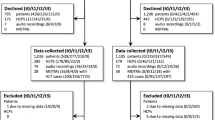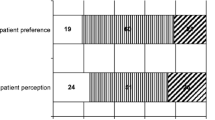Abstract
Although shared decision making (SDM) is the crux of patient-centered care, physicians are not formally trained in SDM. We conducted a pre-/post-test study with oncology residents to evaluate the feasibility and acceptability of a SDM training intervention. Of 20 medical residents approached, 11 participated and rated the SDM workshop favorably. Quality of SDM provided to simulated patients were median 3.5 out of 10 (range, 1–6) at baseline, eight (4–10) within 1 month, and four (2–10) within 3 months of the workshop with higher scores reflecting more elements of SDM demonstrated. Three months after the workshop, participants reported increased sense of control over providing SDM and higher perceived expectations from others to do so. It was feasible to provide SDM training and findings suggest it increased their SDM skills. Changes in behavioral intentions appear to be influenced through the pathways of perceived behavioral control and social norms.

Similar content being viewed by others
References
Institute of Medicine (2001) Crossing the quality chasm: a new health system for the 21st century. National Academy of Sciences, New York
Weston WW (2009) Informed and shared decision-making: the crux of patient-centered care. Can Med Assoc J 165(4):438–439
Kiesler DJ, Auerbach SM (2006) Optimal matches of patient preferences for information, decision-making and interpersonal behaviour: evidence, models and interventions. Patient Educ Couns 61:319–341
Elwyn G, Hutchings H, Edwards A, Rapport F, Wensing M, Cheung WY et al (2005) The OPTION scale: measuring the extent that clinicians involve patients in decision-making tasks. Health Expect 8(1):34–42
Loh A, Simon D, Hennig K, Hennig B, Harter M, Elwyn G (2006) The assessment of depressive patients’ involvement in decision making in audio-taped primary care consultations. Patient Educ Couns 63(3):314–318
Stevenson FA, Cox K, Britten N, Dundar Y (2004) A systematic review of the research on communication between patients and health care professionals about medicines: the consequences for concordance. Health Expect 7(3):235–245
Guimond P, Bunn H, O’Connor AM, Jacobsen MJ, Tait VK, Drake ER et al (2003) Validation of a tool to assess health practitioners’ decision support and communication skills. Patient Educ Couns 50(3):235–245
Gattellari M, Ward JE (2005) Men’s reactions to disclosed and undisclosed opportunistic PSA screening for prostate cancer. Med J Aust 182(8):386–389
O’Connor AM, Sun Q, Dodin S, Feldman-Stewart D, Man-Son-Hing M, Laupacis A et al (2005) Predicting downstream effects of high decisional conflict. 3rd International Shared Decision Making Conference, Ottawa
Makoul G, Clayman ML (2006) An integrative model of shared decision making in medical encounters. Patient Educ Couns 60(3):301–312
Legare F, Stacey D, Pouliot S, Gauvin FP, Desroches S, Kryworuchko J et al (2011) Interprofessionalism and shared decision-making in primary care: a stepwise approach towards a new model. J Interprof Care 25(1):18–25
Wennberg JE (2002) Unwarranted variations in healthcare delivery: implications for academic medical centres. Br Med J 325:961–964
Stacey D, Bennett CL, Barry MJ, Col NF, Eden KB, Holmes-Rovner M et al (2011) Decision aids for people facing health treatment or screening decisions. Cochrane Database Syst Rev 10:1–208
Towle A, Godolphin W (2001) Education and training of health care professionals. In: Edwards A, Elwyn G (eds) Evidence-based patient choice. Inevitable or impossible? Oxford University Press, Oxford, pp 245–269
Towle A, Godolphin W (1999) Framework for teaching and learning informed shared decision making. Br Med J 319:766–771
Legare F, Ratte S, Gravel K, Graham ID (2008) Barriers and facilitators to implementing shared decision-making in clinical practice: update of a systematic review of health professionals’ perceptions. Patient Educ Couns 73(3):526–535
Pellerin MA, Elwyn G, Rousseau M, Stacey D, Robitaille H, Legare F (2011) Toward shared decision-making: using the OPTION scale to analyze resident-patient consultations in family medicine. Acad Med 86(8):1010–1018
Legare F, Ratte S, Stacey D, Kryworuchko J, Gravel K, Graham ID et al (2010) Interventions for improving the adoption of shared decision making by healthcare professionals. Cochrane Database Syst Rev 5:1–46
Legare F, Turcotte S, Stacey D, Ratte S, Kryworuchko J, Graham ID (2012) Patients’ perceptions of sharing in decisions: a systematic review of interventions to enhance shared decision making in routine clinical practice. Patient 5(1):1–19
Legare F, Politi M, Drolet R, Desroches S, Stacey D, Bekker H, et al (2012) Training health professionals in shared decision making: An international environmental scan. Patient Educ Couns. doi:10.1016/j.pec.2012.01.002
Stacey D, O’Connor AM, Graham ID, Pomey MP (2006) Randomized controlled trial of the effectiveness of an intervention to implement evidence-based patient decision support in a nursing call centre. J Telemed Telecare 12:410–415
Stacey D, Taljaard M, Drake ER, O’Connor AM (2008) Audit and feedback using the brief Decision Support Analysis Tool (DSAT-10) to evaluate nurse-standardized patient encounters. Patient Educ Couns 73:519–525
Butow P, Juraskova I, Chang S, Lopez AL, Brown R, Bernhard J (2010) Shared decision making coding systems: how do they compare in the oncology context? Patient Educ Couns 78(2):261–268
Legare F (2005) Implementation of the Ottawa Decision Support Framework in five family practice teaching units: an exploratory trial. University of Ottawa, Ottawa
Ajzen I (1991) The theory of planned behavior. Organ Behav Hum Decis Process 50:179–211
Department of Family Medicine (2004) Residency booklet. University of Ottawa, Ottawa
Acknowledgments
Funding was received from the Educational Initiatives in Residence Education Fund in the Faculty of Medicine, University of Ottawa (June 2007 to May 2008). Dr. F. Legare holds a Canada Research Chair in Implementation of Shared Decision Making in Primary Care. We would like to thank Sara Khangura for her involvement in analyzing the taped encounters with the simulated patients and the oncology residents who gave of their time to take part in the study.
Author information
Authors and Affiliations
Corresponding author
Rights and permissions
About this article
Cite this article
Stacey, D., Samant, R., Pratt, M. et al. Feasibility of Training Oncology Residents in Shared Decision Making: A Pilot Study. J Canc Educ 27, 456–462 (2012). https://doi.org/10.1007/s13187-012-0371-y
Published:
Issue Date:
DOI: https://doi.org/10.1007/s13187-012-0371-y




